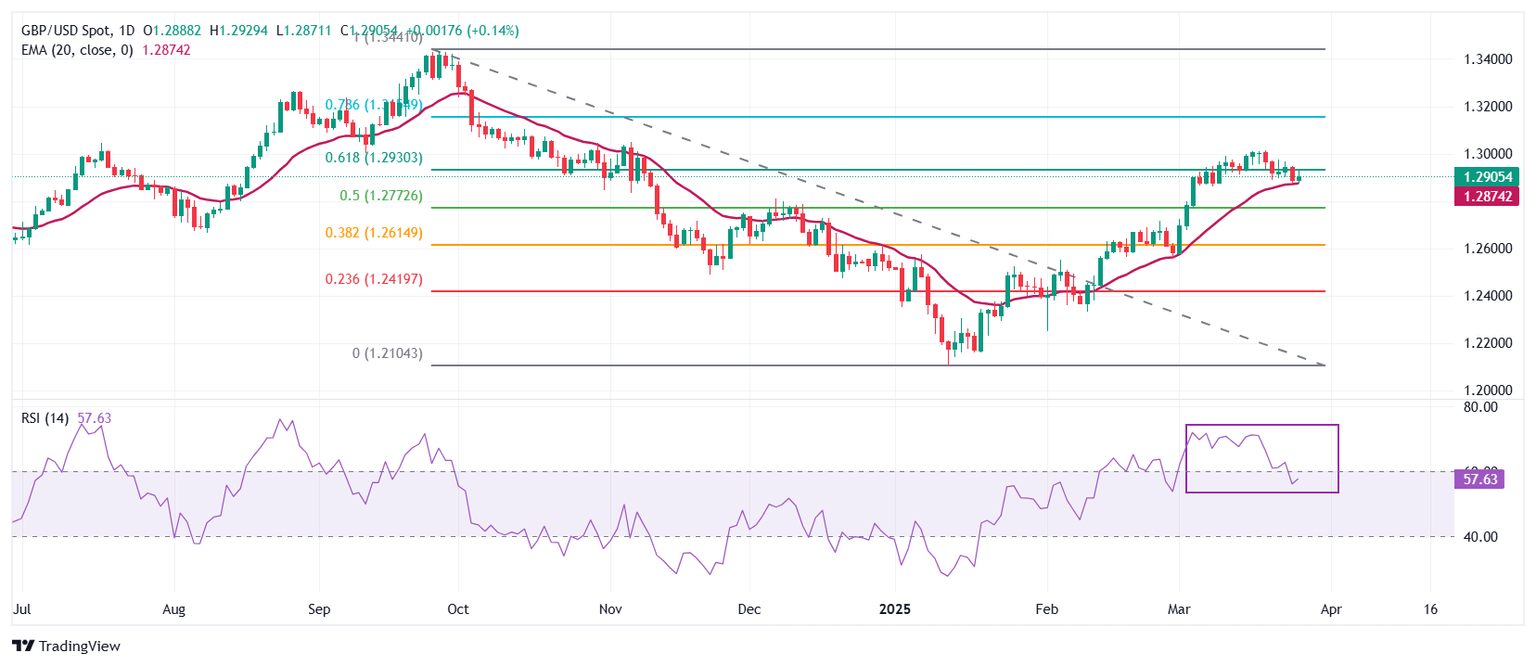Pound Sterling outperforms USD despite Trump's auto tariffs
- The Pound Sterling gains to near 1.2965 against the US Dollar, while investors ignore fresh tariffs by US President Trump on auto imports.
- Fed Kashkari supports leaving interest rates at their current levels for an extended period.
- UK Reeves cuts welfare benefits and remains committed to her fiscal agenda.

The Pound Sterling (GBP) recovers strongly to near 1.2965 against the US Dollar (USD) during North American trading hours on Thursday. The GBP/USD pair bounces back after a slight corrective move in the last five trading days from the four-month high of around 1.3000. The Cable rebounds as the US Dollar retraces even though United States (US) President Donald Trump has imposed 25% tariffs on all imports of automobiles and their components.
The US Dollar Index (DXY), which tracks the Greenback’s value against six major currencies, corrects to near 104.30 from a three-week high around 104.70 posted earlier in the day.
Theoretically, fresh tariffs by US President Trump should have dampened investors’ risk appetite, which results in an increase in demand for safe-haven assets. However, the US Dollar declines as market participants expect that higher levies will also impact US economic growth significantly. The impact of higher tariffs will be borne by US importers, who will pass them on to consumers. Such a scenario will diminish the purchasing power of households.
During European trading hours, United Kingdom (UK) Chancellor of the Exchequer Rachel Reeves said in an interview with Bloomberg TV that our nation will not "impose retaliatory tariffs" as she does not want to "escalate the situation". Reeves added that she would like to see "tariffs between countries fall" as "trade frictions" will make it "harder to grow the economy".
On the monetary policy front, Minneapolis Federal Reserve (Fed) Bank President Neel Kashkari has guided that the central bank should keep interest rates in the current range of 4.25%-4.50%. "Policy uncertainty is complicating the Fed's job," Kashkari said at the Detroit Lakes Chamber Economic Summit on Wednesday. Kashkari added that a potential resurgence in inflation due to Trump’s policies would boost the need for higher interest rates, while its consequences on economic growth will support monetary policy easing. Together, those forces are "kind of a wash," Kashkari added.
Going forward, investors will focus on the US Personal Consumption Expenditures Price Index (PCE) data for February, which will be released on Friday. The impact of the inflation data is expected to be limited on the interest rate outlook as the fate of the Fed’s monetary policy is tied to the outcome of Trump’s economic policies.
During North American trading hours, the US Department of Labor reported that Initial Jobless Claims for the week ending March 21 have come in at 224K, close to estimates and the former reading of 225K. The final estimate for the Q4 Gross Domestic Product (GDP) shows that the economy expanded at a faster pace of 2.4% compared to the revised estimate of 2.3%, Bureau of Economic Analysis (BEA) reported.
Daily digest market movers: Pound Sterling gains ahead of UK Retail Sales data
- The Pound Sterling trades higher against its major peers on Thursday. The British currency recovers most of Wednesday’s losses driven by a softer-than-expected United Kingdom (UK) Consumer Price Index (CPI) data for February and a reduction in welfare benefits announced by Chancellor Reeves in the Spring Statement.
- The UK CPI report showed that inflationary pressures rose at a slower-than-expected pace due to moderate growth in clothing and footwear prices. The headline and the core CPI grew by 2.8% and 3.5% year-over-year, respectively. The Service inflation, which is closely tracked by Bank of England (BoE) officials, rose steadily by 5%. Cooling inflation bodes poorly for the Pound Sterling as it can drive BoE dovish bets.
- As promised, Chancellor Reeves didn’t announce any tax raise, reiterated fiscal rules as non-negotiable, and confirmed a £2.2bn increase in defence spending amid uncertainty surrounding the Ukraine war. Reeves said that she would rebuild a nearly 10 billion-pound fiscal buffer and conveyed that amendments in welfare spending would save £4.8 billion.
- Reeves confirmed a significant downward revision in the Gross Domestic Product (GDP)growth rate for the year and said that the Office for Business Responsibility (OBR) has halved growth forecasts to 1%. However, the fiscal watchdog raised growth forecasts for the next four years.
- Going forward, investors will focus on the UK Q4 GDP data and the Retail Sales data for February, which will be published on Friday.
Technical Analysis: Pound Sterling recovers to near 1.2965
The Pound Sterling rebounds against the US Dollar after finding buying interest near the 20-day Exponential Moving Average (EMA), which trades around 1.2873. The GBP/USD pair attempts to stabilize around the 61.8% Fibonacci retracement, plotted from late-September high to mid-January low, at 1.2930.
The 14-day Relative Strength Index (RSI) cools down to near 60.00 after turning overbought above 70.00. Should a fresh bullish momentum come into action if the RSI resumes the upside journey after holding above 60.00.
Looking down, the 50% Fibonacci retracement at 1.2770 and the 38.2% Fibonacci retracement at 1.2615 will act as key support zones for the pair. On the upside, the October 15 high of 1.3100 will act as a key resistance zone.
Tariffs FAQs
Tariffs are customs duties levied on certain merchandise imports or a category of products. Tariffs are designed to help local producers and manufacturers be more competitive in the market by providing a price advantage over similar goods that can be imported. Tariffs are widely used as tools of protectionism, along with trade barriers and import quotas.
Although tariffs and taxes both generate government revenue to fund public goods and services, they have several distinctions. Tariffs are prepaid at the port of entry, while taxes are paid at the time of purchase. Taxes are imposed on individual taxpayers and businesses, while tariffs are paid by importers.
There are two schools of thought among economists regarding the usage of tariffs. While some argue that tariffs are necessary to protect domestic industries and address trade imbalances, others see them as a harmful tool that could potentially drive prices higher over the long term and lead to a damaging trade war by encouraging tit-for-tat tariffs.
During the run-up to the presidential election in November 2024, Donald Trump made it clear that he intends to use tariffs to support the US economy and American producers. In 2024, Mexico, China and Canada accounted for 42% of total US imports. In this period, Mexico stood out as the top exporter with $466.6 billion, according to the US Census Bureau. Hence, Trump wants to focus on these three nations when imposing tariffs. He also plans to use the revenue generated through tariffs to lower personal income taxes.
Author

Sagar Dua
FXStreet
Sagar Dua is associated with the financial markets from his college days. Along with pursuing post-graduation in Commerce in 2014, he started his markets training with chart analysis.


















